Search results for: 'For'
-
 Shabti for Ly-hotep-em-mut
Shabti for Ly-hotep-em-mutStunning Egyptian funerary figurine from the time of the 22nd dynasty. Formerly in the Rolls-Royce family collection.
Price: on request Ushabti for Ra-mes
Ushabti for Ra-mesThe mummiform funerary figurine dates to the Late Period of ancient Egypt, 26th to 31st dynasty. It is remarkable that it probably originates from the burial of two brothers, Ra-mes and Somtus-tefnacht.
Price: on request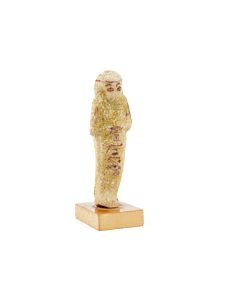 Egyptian ushabti for Nisi-ta-udjat-achet
Egyptian ushabti for Nisi-ta-udjat-achetInteresting figurine made of green faience with black paint. A typical funerary statuette from the Third Intermediate Period of ancient Egypt.
Price: on request Egyptian ushabti for Horus-in-Chemmis
Egyptian ushabti for Horus-in-ChemmisFunerary statuette made of turquoise faience with black paint and cute name inscription.
Price: on request Shabti for Djed Khonsu
Shabti for Djed KhonsuExceptional funerary statuette from Deir el-Medina. Third Intermediate Period of Ancient Egypt.
Price: on request Egyptian ushabti for Ra-mes
Egyptian ushabti for Ra-mesThe mummiform funerary figurine dates to the Late Period of ancient Egypt, 26th to 31st dynasty. It is remarkable that it probably originates from the burial of two brothers, Ra-mes and Somtus-tefnacht.
Price: on request Egyptian ushabti for Somtus-tefnacht
Egyptian ushabti for Somtus-tefnachtThe mummiform funerary figurine dates to the Late Period of ancient Egypt, 26th to 31st dynasty. It is remarkable that it probably originates from the burial of two brothers, Somtus-tefnacht and Somtus-tefnacht.
Price: on request Egyptian ushabti for Somtus-tefnacht
Egyptian ushabti for Somtus-tefnachtThe mummiform funerary figurine dates to the Late Period of ancient Egypt, 26th to 31st dynasty. It is remarkable that it probably originates from the burial of two brothers, Somtus-tefnacht and Somtus-tefnacht.
Price: on request Egyptian ushabti for Somtus-tefnacht
Egyptian ushabti for Somtus-tefnachtThe mummiform funerary figurine dates to the Late Period of ancient Egypt, 26th to 31st dynasty. It is remarkable that it probably originates from the burial of two brothers, Somtus-tefnacht and Somtus-tefnacht.
Price: on request Egyptian ushabti for Ra-mes
Egyptian ushabti for Ra-mesThe mummiform funerary figurine dates to the Late Period of ancient Egypt, 26th to 31st dynasty. It is remarkable that it probably originates from the burial of two brothers, Ra-mes and Somtus-tefnacht.
Price: on request Egyptian funerary figurine for Nefer-hotep
Egyptian funerary figurine for Nefer-hotepInteresting ushabti from Memphis dating to the late 19th Dynasty, New Kingdom. The owner was an official from the Temple of Ptah.
Price: on request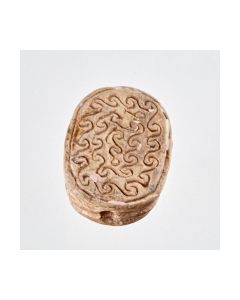 Scarab with spiral design and symbol for good luck
Scarab with spiral design and symbol for good luckThe Egyptian scarab from the Second Intermediate Period is decorated with a geometrical pattern. A nefer hieroglyph stands for good luck.
Price: on request Extremely rare aureus of Saturninus coined for Probus - 7th known specimen of this coin
Extremely rare aureus of Saturninus coined for Probus - 7th known specimen of this coinDie 7. weltweit bekannte Münze des Saturninus überhaupt und damit eines der seltensten Stücke der römischen Numismatik in exzellenter Erhaltung.
Price: on request Scarab with magic formula
Scarab with magic formulaThe stamp shows the anra formula in a cartouche. The amulet should thus serve a magic or ritual purpose for its owner.
Price: on request Ägyptisches Amulett in Form des Udjatauges
Ägyptisches Amulett in Form des UdjataugesVoll dekoriertes Udjatauge (Auge des Horus) mit schwarz aufgetragener Pupille und geritzten Details. Aus der 22. bis 25. Dynastie des Alten Ägyptens.
Price: on request Flint blade and stone mould
Flint blade and stone mouldInteresting group of two artefacts. A Neolithic flint blade from Egypt and a Bronze Age mould for casting or hammering metal.
Price: on request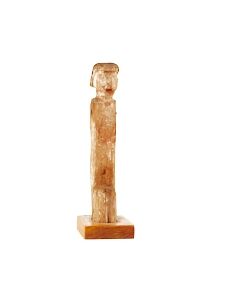 Egyptian wooden statuette
Egyptian wooden statuetteFigure painted in black and red from the 12th dynasty of ancient Egypt. Probably part of a larger wooden model for a tomb.
Price: on request Egyptian faience statuette of Taweret
Egyptian faience statuette of TaweretSimplistic depiction of the protective goddess for pregnant women. It can be worn as an amulet. A piece from the Late Period of Ancient Egypt.
Price: on request Egyptian Kohl vessel
Egyptian Kohl vesselThe small stone pot of nicely polished granite was used for Kohl, the eye cosmetic of the ancient Egyptians. From the time between Middle Kingdom and New Kingdom.
Price: on request Egyptian wooden statuette
Egyptian wooden statuetteFigure painted in black and red from the 12th dynasty of ancient Egypt. Probably part of a larger wooden model for a tomb.
Price: on request Egyptian amulet of Bes
Egyptian amulet of BesProtective amulet with dwarf god Bes. A typical specimen for its kind from Ancient Egypt.
Price: on request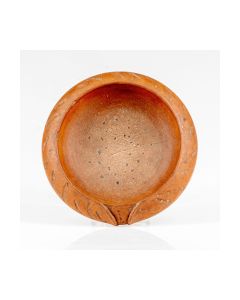 Rare Roman Terra Sigillata mortar
Rare Roman Terra Sigillata mortarMassive pottery bowl used for rasping, excellent condition. Decorated with stamps showing stylized feet and palm leaves. From an old German private collection, acquired in 1977.
Price: on request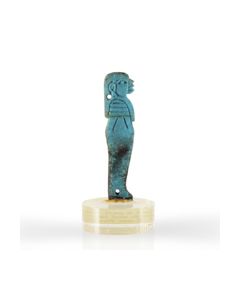 Appliqué of the Horus Son Imsety from Faiyum
Appliqué of the Horus Son Imsety from FaiyumMade of nice turquoise faience. Protective god responsible for the liver of a deceased. From the family of Lawrence of Arabia.
Price: on request Appliqué of the Horus Son Imsety
Appliqué of the Horus Son ImsetyRare variety with wooden core and gilded linen. Protective god responsible for the liver of a deceased. From the family of Lawrence of Arabia.
Price: on request Egyptian frog lamp from very old German collection
Egyptian frog lamp from very old German collectionThe frog lamps developed in Egypt close to Abydos. For the Egyptians, the frog symbolized birth and resurrection, this symbolism was also adapted by the early Christians. From the German collection Becker, in this for 3 generations.
Price: on request Scaraboid from the Middle Kingdom
Scaraboid from the Middle KingdomThe stamp shows hieroglyphs with a title for the king of Upper and Lower Egypt. This scaraboid is described in the catalogue of Irène Gautier-Vodoz.
Price: on request Egyptian faience ring showing Bes and Taweret
Egyptian faience ring showing Bes and TaweretThe finger ring with its scene on the plate must have served a protective function for an expectant mother. New Kingdom, approx. 1550 to 1070 BC.
Price: on request Applique of the Horus son Duamutef
Applique of the Horus son DuamutefBright turquise fayence. Duamutef is one of the four sons of Horus, well-known from the Canopic jars. He had an important protective function for the dead. Egypt, 8th to 4th cent. BC.
Price: on request Slender Egyptian stone beaker
Slender Egyptian stone beakerThe small and tall stone vessel is made of alabaster. From the collection of Egyptologist Professor Wiedemann.
Price: on request Egyptian stone beaker
Egyptian stone beakerThe elegant stone vase was probably used as an ointment vessel. 5th to 6th dynasty of ancient Egypt, Old Kingdom.
Price: on request Perfectly preserved ampulla of Saint Menas
Perfectly preserved ampulla of Saint MenasFrühchristliche Pilgerflasche mit Darstellung des Heiligen Menas. Aus der sehr alter US-Amerikanischer Sammlung des Pharmakologen Prof. Dilling, erworben in den frühen 1900er Jahren. Als Kauf- oder Fundort ist Alexandria überliefert.
Price: on request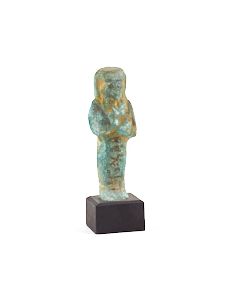 Egyptian ushabti
Egyptian ushabtiFunerary statuette made of turquoise faience with black paint. 21st dynasty of ancient Egypt.
Price: on request Egyptian bronze figurine of Khonsu the Child
Egyptian bronze figurine of Khonsu the ChildRare depiction of the god of the moon Khonsu in the manner of the Egyptian child gods. From the Late Period of Ancient Egypt. A find from Karnak.
Price: on request Egyptian chalice
Egyptian chaliceThe thin-walled stone cup is reminiscent of a lotus bud. From the collection of Egyptologist Professor Wiedemann. 18th dynasty of Ancient Egypt.
Price: on request Harpokrates Terracotta figurine from Ptolemaic or Roman Egypt
Harpokrates Terracotta figurine from Ptolemaic or Roman EgyptNice figurine from Ptolemaic or Roman Egypt. From an old German collection, acquired at Davies Antiques, London, in 1976 - 1978.
Price: on request Egyptian mummy beads necklace
Egyptian mummy beads necklaceModern assembled and threaded necklace made from original ancient Egyptian beads. The socalled mummy beads are made of faience and date to the Late Period of ancient Egypt.
Price: on request

